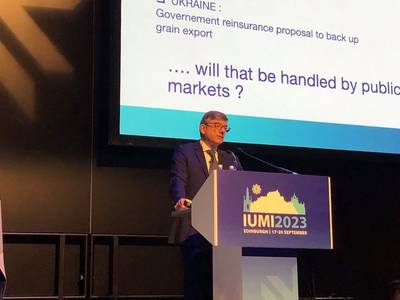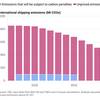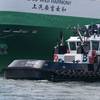Marine Insurance Market is “Strength and Stability in Turbulent Seas”
Opening this week’s International Union of Marine Insurance (IUMI) annual conference in Edinburgh, Scotland, President Frédéric Denèfle explained the conference theme of “strength and stability in turbulent seas” saying it is essentially “business as usual” for marine underwriters.
“As marine underwriters, we are used to managing an array of casualties and losses onboard a variety of vessels and in ports and other shoreside facilities. Dealing with the fall-out from natural catastrophes such as earthquakes and weather events are also workaday issues. Similarly, operating amongst geopolitical chaos is an ongoing problem we face but this has been exacerbated recently with the war in Ukraine.
“Marine insurers actively supported the creation of the original grain corridor to ensure that Ukrainian exports could still continue. Now that agreement has broken down, marine insurers are in discussions with the Ukrainian government to provide cover for the vessels moving Ukrainian cargoes.”
Denèfle explained how fragmentation was causing headaches. From a trade perspective, covid had highlighted a range of strategic dependencies. It had led to a general reduction in global demand and had encouraged a relocation of activity closer to the consumer. On the legal side, shipping and insurance was being targeted with increased sanctions as well as local green regulations where, for example, some jurisdictions will not register vessels above a certain age. As the unified spokesperson for marine insurers, IUMI has liaised with various authorities and regulators to support both the industry and underwriters.
A consequence of inflation, caused by covid and the war in Ukraine was already manifesting itself in the increased cost of claims, the requirement to take on more risk as asset values increase, and a related need for more capacity in the market. Added to this, a general technology shift in terms of clean energy, clean propulsion and autonomous vessels was creating more “turbulence.” However, all new technologies and climate change reduction measures are welcomed by IUMI which stands ready to act as an enabler to their introduction.
Although the marine insurance market was in a state of flux, Denèfle was confident in its ability to cope: “As the world’s oldest insurance business, our sector has demonstrated its ability to flex to new needs and conditions, both market and macro-economic. I foresee a return to dedicated, experienced teams; a heightened reliance on intelligence and data systems to anticipate the consequences of geopolitical uncertainty; the emergence of local teams underwriting local business in their own areas to challenge fragmentation; an adjustment of market capacities and pricing to fight inflation pressures; and the creation of specialist teams to fully understand the implications of new technologies. Of course, much of this is already happening.”
The IUMI also presented its analysis of the latest marine insurance market trends at the annual conference. All lines of business reported an uplift in their global premium base for 2022 with the total reaching $35.8 billion, representing an 8.3% increase on the previous year. Global income was split by region: Europe 47.7%, Asia/Pacific 28.4%, Latin America 10.3%, North America 8.5%, Other 5.1%.
By line of business, the largest share was commanded by transport/cargo at 57.3% followed by global hull 23.4%, offshore energy 11.5% and marine liability (other than P&I covered by IG clubs) 7.7%.
Astrid Seltmann, Vice-Chair of IUMI’s Facts & Figures Committee, provided some context: “Marine underwriters have suffered poor returns over several years but from 2020 results started to improve. 2021 and particularly 2022 have shown a relatively strong growth in the global premium base across all lines of business. In combination with a benign claims impact, this has translated into a much better performance in terms of loss ratios, specifically for hull and cargo.”
Jun Lin, Chair of IUMI’s Facts & Figures Committee, sums up: “The overall results from our 2022 analysis do appear to indicate positive growth which is welcomed after a prolonged period of poor returns. Inflation has fallen slightly which is also positive but interest rates remain high which can mask the underperformance of the underwriting sector. However, consumer confidence is slowly recovering which should help the container trades; and I’m hearing reports that the slowdown in China might not be as severe as some believe.
“That said, we shouldn’t lose sight of future challenges that are likely to inject a degree of uncertainty into all our lines of business. Asset prices continue to rise and inflationary pressure will only add to the value of claims. The oil price is fluctuating and global trade forecasts vary. Trade routes are changing, not least as a result of the war in Ukraine which, itself, is changing the political landscape.
“New cargoes such as lithium-ion batteries are creating new risks that must be fully understood and mitigated, as are new propulsion technologies resulting from our combined environmental protection ambitions. And, of course, climate change and new weather events are also making themselves known to insurers. Added to this, we are managing new types of risk such as cyber and having to deal with the accumulation of risk as cargo of increasing value is being stored in single port facilities or is being carried on vessels that continue to grow in capacity.
“Marine underwriting is the oldest form of insurance and one that has adapted to change and evolution over hundreds of years. Of late, we have seen a much welcomed reversal of fortunes for marine insurers and I’m confident this will enable underwriters to manage future change and continue to provide the best possible cover for their assureds.”












